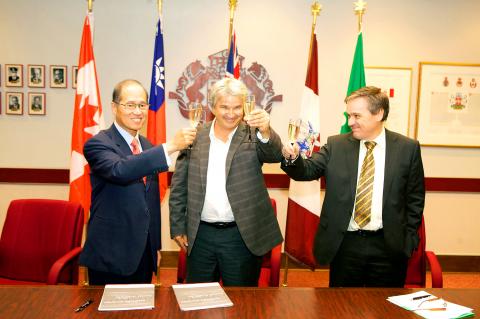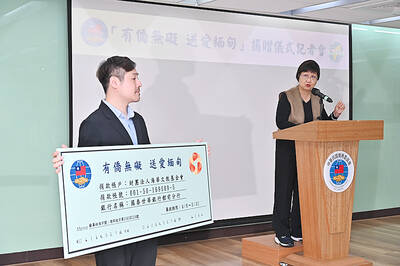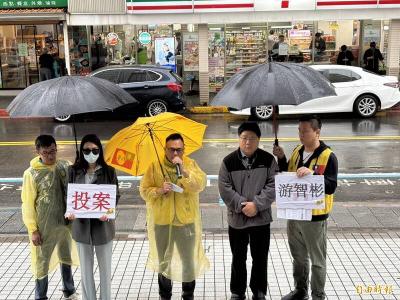An enthusiastic crowd packed the Tabaret Hall at the University of Ottawa on Wednesday evening for the official launch of the chair of Taiwan Studies at the Canadian capital’s top university.
The chair was made possible following an agreement between the university and Taiwan’s Ministry of Education.
The designated titular of the chair is professor Scott Simon from the department of sociology and anthropology, with professor Andre Laliberte of the school of political studies acting as co-chair.

Photo courtesy of Robert Lacombe, University of Ottawa
The chair will be interdisciplinary and extend to fields including political studies, anthropology, sociology, economics and development.
During the ceremony, which was co-organized by the Taipei Economic and Cultural Office, Simon said the university had already signed agreements with five Taiwanese universities.
“In the Faculty of Social Science, we already have two scholars who have been doing Taiwan Studies for well over a decade, with many publications. This is in addition to cutting-edge work in such fields as medicine and the hard sciences done in collaboration between [University of Ottawa] professors and Taiwanese scholars,” he said.
Laliberte said Taiwan’s unique situation could serve as inspiration for a wide number of issues.
“I am delighted to have the opportunity to teach our students about this democratic republic, from which we can learn a lot in the fields of science and public policy. Taiwan has a rich political culture and a tumultuous history that is sure to inspire debate in every sector of political science,” Laliberte said. “In the field of comparative politics, Taiwan has, since 1945, served as an experiment, with implications for all the great political questions of our time ... institutional reform, the separation of power and electoral development, all of which are part of the ‘Taiwanese experiment.’”

DEFENSE: The National Security Bureau promised to expand communication and intelligence cooperation with global partners and enhance its strategic analytical skills China has not only increased military exercises and “gray zone” tactics against Taiwan this year, but also continues to recruit military personnel for espionage, the National Security Bureau (NSB) said yesterday in a report to the Legislative Yuan. The bureau submitted the report ahead of NSB Director-General Tsai Ming-yen’s (蔡明彥) appearance before the Foreign and National Defense Committee today. Last year, the Chinese People’s Liberation Army (PLA) conducted “Joint Sword-2024A and B” military exercises targeting Taiwan and carried out 40 combat readiness patrols, the bureau said. In addition, Chinese military aircraft entered Taiwan’s airspace 3,070 times last year, up about

A magnitude 4.3 earthquake struck eastern Taiwan's Hualien County at 8:31am today, according to the Central Weather Administration (CWA). The epicenter of the temblor was located in Hualien County, about 70.3 kilometers south southwest of Hualien County Hall, at a depth of 23.2km, according to the administration. There were no immediate reports of damage resulting from the quake. The earthquake's intensity, which gauges the actual effect of a temblor, was highest in Taitung County, where it measured 3 on Taiwan's 7-tier intensity scale. The quake also measured an intensity of 2 in Hualien and Nantou counties, the CWA said.

The Overseas Community Affairs Council (OCAC) yesterday announced a fundraising campaign to support survivors of the magnitude 7.7 earthquake that struck Myanmar on March 28, with two prayer events scheduled in Taipei and Taichung later this week. “While initial rescue operations have concluded [in Myanmar], many survivors are now facing increasingly difficult living conditions,” OCAC Minister Hsu Chia-ching (徐佳青) told a news conference in Taipei. The fundraising campaign, which runs through May 31, is focused on supporting the reconstruction of damaged overseas compatriot schools, assisting students from Myanmar in Taiwan, and providing essential items, such as drinking water, food and medical supplies,

New Party Deputy Secretary-General You Chih-pin (游智彬) this morning went to the National Immigration Agency (NIA) to “turn himself in” after being notified that he had failed to provide proof of having renounced his Chinese household registration. He was one of more than 10,000 naturalized Taiwanese citizens from China who were informed by the NIA that their Taiwanese citizenship might be revoked if they fail to provide the proof in three months, people familiar with the matter said. You said he has proof that he had renounced his Chinese household registration and demanded the NIA provide proof that he still had Chinese